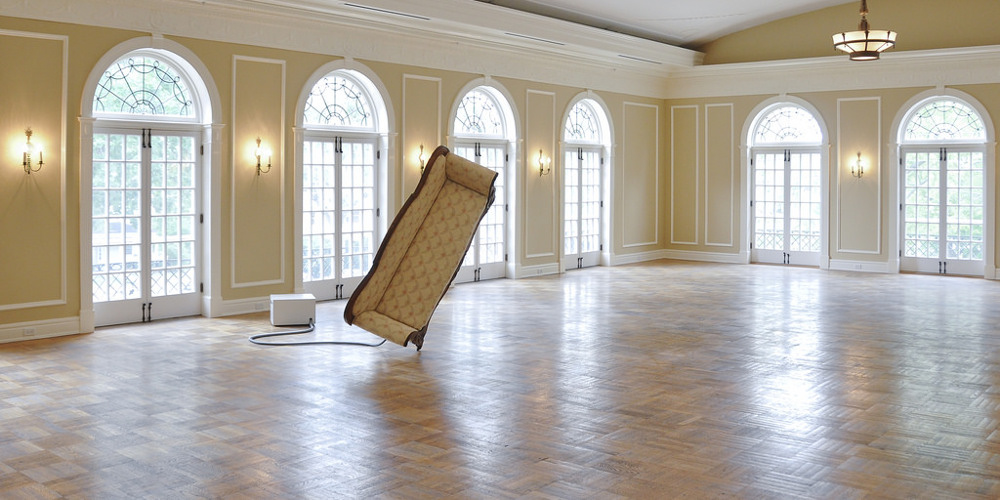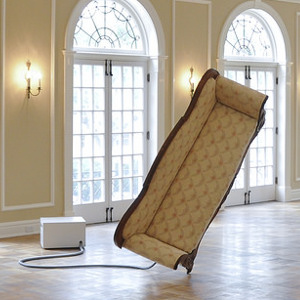
In order to maintain interpersonal relationships, a certain balance must be found which can only be achieved by continuously adjusting and adapting. This difficult balancing act is shown by the US-American artist Jacob Tonski in the installation “Balance from Within”. For this he received an award at the Prix Ars Electronica 2014 in the category Interactive Art.
Balance from Within is a 170-year-old and 40-kilogram sofa that only balance on one leg through the application of a robotic mechanism installed inside it. While the sofa attempts to maintain equilibrium, the installation’s motors produce sounds that resemble muffled groans and creaking. However, due to external influences, the sofa can also be brought down. In order to minimize the resulting damage, the main components of the sofa are held together with magnets, so that the individual parts can be easily separated from each other and the sofa is easy to reassemble.
How he experienced the moment when the sofa stood on one leg the very first time and why he, although he does everything that this does not happen, considers the falling down of the sofa as an essential part of his project, Jacob Tonski has told us in in an interview.
Hallo Jacob! In 2008 you also made a Balance Study. What fascinates you about the act of balancing?
Jacob Tonski: It’s very complex, and it’s difficult to do. Yet we do it all the time, seemingly effortlessly. I’ve learned that it’s a highly dynamic process. When we stand still it seems as if we are rooted like a tall building, and yet our muscles are incessantly correcting our position in a dance with gravity. I find this an insightful metaphor for all the forces we balance in life.
Having watched my children learn how to walk, as well as having learned how to ride a unicycle have both taught me enormous amounts about the importance of attention to details and subtlety in learning to balance multiple inputs and outputs, simultaneously. You learn to listen and talk to muscles you didn’t even know you had. You learn to think about things you didn’t know you could think about.
Did you have any inspirations for Balance from Within?
Jacob Tonski: The idea grew out of playing with a chair, trying to balance it on one leg. There’s a moment before it falls that’s briefly wonderful, where it’s defying gravity. Doing it at a scale matched to the body seemed exciting, if ambitious. I did not know if it was even possible to balance something on a rigid point when I started. It was the confluence of these factors that got me started: curiosity, absurdity, cognitive dissonance, a hard engineering problem, a metaphor that provoked me…
The balance of the sofa in Balance from Within is an allegory for balancing an interpersonal relationship. Considering this is a social topic, why did you choose to balance a sofa?
Jacob Tonski: The sofa seems to me one of the most fundamental and long-standing architectures for framing and facilitating social interaction. (This is related to the choice of an antique.) And a sofa is an object that is essentially always seen on its feet. Upending it might help to disrupt expectations.
The internal mechanism of the sculpture is based on a concept known as a reaction wheel, which is normally deployed in satellites. How did you get the idea to get this into a sofa? Was this technology your first choice to balance the sofa?
Jacob Tonski: My research led me to an older robotic research platform known as the Acrobot. As I came to understand, with the help of robotics researcher Garth Zeglin, that it was not the center of mass movement that mattered but in fact the torque applied to the arms of the robot, I saw that a motor simply rotating could produce the desired force, without actuating anything other than itself. It was very unintuitive to me at first. As I studied different designs of motors that would allow high torque at low speeds and low noise levels, I came across the reaction wheel used in satellites and realized this was the same basic concept.
What’s the deal with the sounds the installation’s motors produce?
Jacob Tonski: They are electrical bicycle wheel motors. The particular brand I chose makes a slight hum or whine depending on its speed. They are brushless DC motors, commutated by hall sensor signals, and that system always produces a little electrical and mechanical noise. I’ve since learned how to use a rotary encoder and a different commutation strategy to silence these types of motors, but for this sculpture I am very fond of the sound of struggle it produces. The sounds emitted by the mechanism, for me, are in harmony with the task it is continually performing.
How did you feel, when you saw it balancing the first time?
Jacob Tonski: I had a lot to learn. It was a year after I started research that I finally assembled all the necessary components and fine tuned the system enough to balance itself. It was absolute magic to me. I remember saying several very angry sounding words in very happy ways, very loudly.
As is the case for most people who have built a complex system, I too often only see its component parts. But once in a while I’m able to step back and feel a strange sense of disbelief all over again. That’s pretty nice.
If we try to simultaneously comprehend all the pieces of a system of great complexity, one that’s beyond comprehensible, we can attain a true sense of awe – of our limits and our smallness. That’s not a helpful state of mind for problem solving, but it’s a real gift of being human if you can let it in. It’s humbling, and you can touch the magic. A number of philosophers have named this feeling and described it in great detail. I love feeling it.
Did you try it with other sofas till you get the valuable 170 year old sofa to balance on one leg?
Jacob Tonski: Nope. The poor thing took quite a beating along the way. It’s head was quite deformed by the birth canal, but rounded out nicely with time.
Of course, a single imprudent movement or even some smart-ass installation visitor can cause the sculpture to come crashing to the floor. How important is it that the sofa fall down and crash from time to time?
Jacob Tonski: I prefer it doesn’t fall too much, as each fall takes a toll (we can each insert our own personal life metaphor here). I see it like a person. It has a limited life by design. And so, while watching anything crash and burn is exciting (large % of youtube videos?), and anyone is welcome to enjoy seeing it fall, we can’t just go knocking it down every day. It won’t live very long if we do.
At almost every exhibition opening the piece has been part of, someone curious has pushed it over. It is, admittedly, very exciting for everyone around. On some level, I think those bold few have the best experience of all.
They will probably never forget the day they decided to intentionally knock over a sculpture in an art exhibition. I like to imagine they think they’ve destroyed it. I doubt any of those people have hung around long enough after that to see it reassembled and stood up once again. I love that a handful of people have this dark secret. I wonder if they tell their friends.
Your project got an Award of Distinction in the category Interactive Art. How can Balance from Within be interactive?
Jacob Tonski: Balance From Within interacts with the world around it. It uses what is called a closed loop feedback control system, but there are still inputs to the system which cannot be known in advance, such as wind, the push of a passerby, or the gradual small shifts in position of the pieces of the sofa. The mode of interaction is not viewer-centric, but object-centric. (Please also see my answer to the previous question)
If you want to see this unique installation with your own eyes, you should come to the Ars Electronica Festival from 4th to 8th September. Balance from Within is shown at the cyberArts exhibition at the OK Center for Contemporary Art Upper Austria. On 6th September you also have the opportunity to personally speak with the artist Jacob Tonski in the Prix forums.
